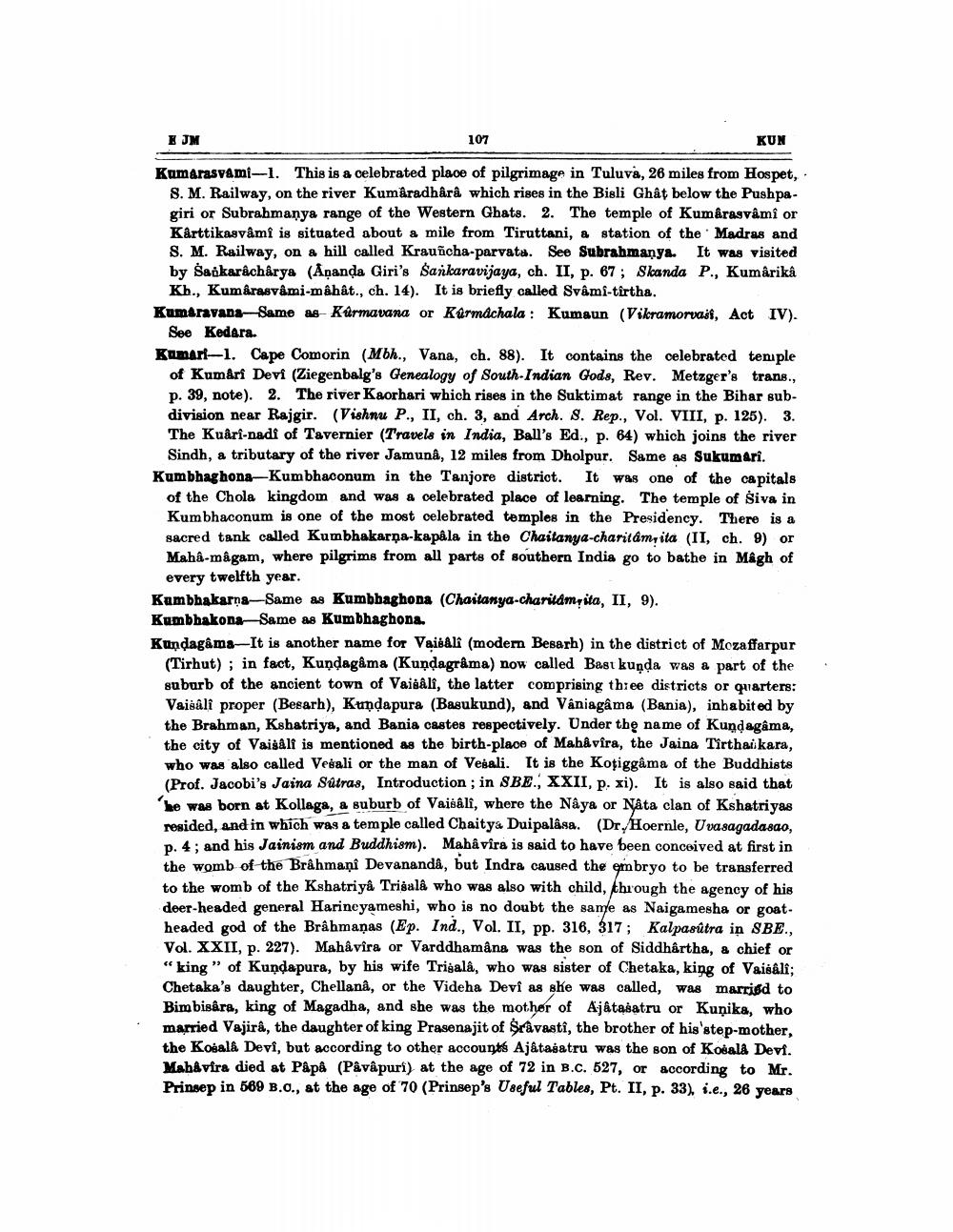________________
KJM
107
KUN
Kumarasvami-1. This is a celebrated place of pilgrimage in Tuluva, 26 miles from Hospet,
8. M. Railway, on the river Kumaradhârâ which rises in the Bisli Ghat below the Pushpagiri or Subrahmanya range of the Western Ghats. 2. The temple of Kumârasvâmî or Kárttikasvami is situated about a mile from Tiruttani, a station of the Madras and S. M. Railway, on a hill called Krauicha-parvata. See Subrahmanya. It was visited by Sankaracharya (Apanda Giri's Sankaravijaya, ch. II, p. 67 ; Skanda P., Kumârika
Kb., Kumarasvâmi-mâhât., ch. 14). It is briefly called Svâmi-tirtha. Kumaravana-Same as Kurmavana or Karmachala: Kumaun (Vikramorvaši, Act IV).
See Kedara. Kamart--1. Cape Comorin (Mbh., Vana, ch. 88). It contains the celebrated teniple
of Kumari Devi (Ziegenbalg's Genealogy of South Indian Gods, Rev. Metzger's trans., p. 39. note). 2. The river Kaorhari which rises in the Suktimat range in the Bihar subdivision near Rajgir. (Vishnu P., II, ch. 3, and Arch. 8. Rep., Vol. VIII, p. 125). 3. The Kukri-nadi of Tavernier (Travels in India, Ball's Ed., p. 64) which joins the river
Sindh, a tributary of the river Jamuna, 12 miles from Dholpur. Same as Sukumari. Kumbhaghona-Kumbhaconum in the Tanjore district. It was one of the capitals
of the Chola kingdom and was a celebrated place of learning. The temple of Siva in Kumbhaconum is one of the most celebrated temples in the Presidency. There is a sacred tank called Kumbhakarna-kapala in the Chaitanya-charitam,ita (II, ch. 9) or Mahâ-magam, where pilgrims from all parts of southern India go to bathe in Magh of
every twelfth year. Kumbhakarna-Same as Kumbbaghona (Chaitanya-charitam ita, II, 9). Kumbhakona Same as Kumbhaghona. Kundagams-It is another name for Vaibali (modern Besarh) in the district of Mozaffarpur
(Tirhut); in fact, Kundagama (Kundagráma) now called Bast kuņda was a part of the suburb of the ancient town of Vaisali, the latter comprising three districts or quarters: Vaisali proper (Besarh), Kundapura (Basukund), and Vâniagama (Bania), inhabited by the Brahman, Kshatriya, and Bania castes respectively. Under the name of Kundagama, the city of Vaišali is mentioned as the birth-place of Mahavira, the Jaina Tirthai kara, who was also called Vegali or the man of Vesali. It is the Koțiggâma of the Buddhists (Prof. Jacobi's Jaina Sutras, Introduction ; in SBE., XXII, p. xi). It is also said that he was born at Kollaga, a suburb of Vaišáli, where the Naya or Nåta clan of Kshatriyas resided, and in which was a temple called Chaitya Duipalâsa. (Dr. Hoernle, Uvasagadasao, p. 4; and his Jainism and Buddhism). Mahavira is said to have been conceived at first in the womb of the Brahmanî Devananda, but Indra caused the embryo to be transferred to the womb of the Kshatriyâ Trisalâ who was also with child, through the agency of his deer-headed general Harineyameshi, who is no doubt the same as Naigamesha or goatheaded god of the Brâhmanas (Ep. Ind., Vol. II, pp. 316, 317; Kalpasútra in SBE., Vol. XXII, p. 227). Mahavira or Varddhamâna was the son of Siddhartha, a chief or "king" of Kundapura, by his wife Trigalâ, who was sister of Chetaka, king of Vaisâli; Chetaka's daughter, Chellanå, or the Videha Devî as she was called, was married to Bimbisåra, king of Magadha, and she was the mother of Ajátasatru or Kuņika, who married Vajira, the daughter of king Prasenajit of Sravastî, the brother of his step-mother, the Kosala Devi, but according to other accounts Ajátagatru was the son of Kosala Devi. Mahavira died at Pâpå (Pâvâpuri) at the age of 72 in B.C. 527, or according to Mr. Prinsep in 569 B.O., at the age of 70 (Prinsep's Useful Tables, Pt. II, p. 33), i.e., 26 years




